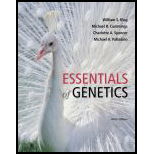
Concept explainers
CASE STUDY |An unexpected outcome
A newborn screening program identified a baby with a rare autosomal recessive disorder called arginosuccinate aciduria (AGA), which causes high levels of ammonia to accumulate in the blood. Symptoms usually appear in the first week after birth and can progress to include severe liver damage, developmental delay, and mental retardation. AGA occurs with a frequency of about 1 in 70,000 births. There is no history of this disorder in either the father's or mother's family. This case raises several questions:
Since it appears that the unaffected parents are heterozygotes, would it be considered unusual that there would be no family history of the disorder? How would they be counseled about risks to future children?
Case summary:
A baby was identified with an autosomal recessive disorder AGA (Arginosuccinate aciduria) that causes the high levels of ammonia accumulation in the blood. After first week of the birth, symptoms appear that leads into the severe liver damage, developmental delay, and mental retardation.
Characters in the case:
A baby with AGA disorder.
Adequate information:
Accumulation of ammonia in the blood occurs in this disorder. Symptoms include sever liver damage, developmental delay, and mental retardation.
To determine:
The unaffected parents are heterozygous that could be consider as unusual as there were no family history of this disorder. They would have counseled about the risks to future children.
Explanation of Solution
Given information:
AGA (Arginosuccinate aciduria) is a genetic disorder that causes the accumulation of ammonia in the blood. The probability of this disorder is 1 in 70,000 births.
AGA is a heritable disorder that directly affects the nervous system that is caused by the accumulation of the argininosuccinic acid in the blood and also in the urine, while some of the patients are subjected to the accumulation of the ammonia.
Mutation in the ASL gene is responsible for the AGA. AGA follows the pattern of autosomal recessive pattern in which two copies of the gene in each cell got altered. The parents of the person with this disorder are the carriers of one copy of the altered gene and do not show any kind of signs and symptoms of this disorder. This is not unusual as in the history of the family no one was affected by this disorder and this will only happen when two heterozygous individuals meet. The risk of future child to be affected by AGA is of high frequency. There is 25% chances of having affected child with every future child.
Therefore, it can be concluded that the risk associated with each child for this disease is 25%.
Want to see more full solutions like this?
Chapter 22 Solutions
Essentials of Genetics (9th Edition) - Standalone book
- Explain how the hormones of the glands listed below travel around the body to target organs and tissues : Pituitary gland Hypothalamus Thyroid Parathyroid Adrenal Pineal Pancreas(islets of langerhans) Gonads (testes and ovaries) Placentaarrow_forwardWhat are the functions of the hormones produced in the glands listed below: Pituitary gland Hypothalamus Thyroid Parathyroid Adrenal Pineal Pancreas(islets of langerhans) Gonads (testes and ovaries) Placentaarrow_forwardDescribe the hormones produced in the glands listed below: Pituitary gland Hypothalamus Thyroid Parathyroid Adrenal Pineal Pancreas(islets of langerhans) Gonads (testes and ovaries) Placentaarrow_forward
- Please help me calculate drug dosage from the following information: Patient weight: 35 pounds, so 15.9 kilograms (got this by dividing 35 pounds by 2.2 kilograms) Drug dose: 0.05mg/kg Drug concentration: 2mg/mLarrow_forwardA 25-year-old woman presents to the emergency department with a 2-day history of fever, chills, severe headache, and confusion. She recently returned from a trip to sub-Saharan Africa, where she did not take malaria prophylaxis. On examination, she is febrile (39.8°C/103.6°F) and hypotensive. Laboratory studies reveal hemoglobin of 8.0 g/dL, platelet count of 50,000/μL, and evidence of hemoglobinuria. A peripheral blood smear shows ring forms and banana-shaped gametocytes. Which of the following Plasmodium species is most likely responsible for her severe symptoms? A. Plasmodium vivax B. Plasmodium ovale C. Plasmodium malariae D. Plasmodium falciparumarrow_forwardStandard Concentration (caffeine) mg/L Absorbance Reading 10 0.322 20 0.697 40 1.535 60 2.520 80 3.100arrow_forward
- please draw in the answers, thank youarrow_forwarda. On this first grid, assume that the DNA and RNA templates are read left to right. DNA DNA mRNA codon tRNA anticodon polypeptide _strand strand C с A T G A U G C A TRP b. Now do this AGAIN assuming that the DNA and RNA templates are read right to left. DNA DNA strand strand C mRNA codon tRNA anticodon polypeptide 0 A T G A U G с A TRParrow_forwardplease answer all question below with the following answer choice, thank you!arrow_forward
 Human Heredity: Principles and Issues (MindTap Co...BiologyISBN:9781305251052Author:Michael CummingsPublisher:Cengage Learning
Human Heredity: Principles and Issues (MindTap Co...BiologyISBN:9781305251052Author:Michael CummingsPublisher:Cengage Learning Biology (MindTap Course List)BiologyISBN:9781337392938Author:Eldra Solomon, Charles Martin, Diana W. Martin, Linda R. BergPublisher:Cengage Learning
Biology (MindTap Course List)BiologyISBN:9781337392938Author:Eldra Solomon, Charles Martin, Diana W. Martin, Linda R. BergPublisher:Cengage Learning
 Biology 2eBiologyISBN:9781947172517Author:Matthew Douglas, Jung Choi, Mary Ann ClarkPublisher:OpenStax
Biology 2eBiologyISBN:9781947172517Author:Matthew Douglas, Jung Choi, Mary Ann ClarkPublisher:OpenStax Biology Today and Tomorrow without Physiology (Mi...BiologyISBN:9781305117396Author:Cecie Starr, Christine Evers, Lisa StarrPublisher:Cengage Learning
Biology Today and Tomorrow without Physiology (Mi...BiologyISBN:9781305117396Author:Cecie Starr, Christine Evers, Lisa StarrPublisher:Cengage Learning Biology: The Unity and Diversity of Life (MindTap...BiologyISBN:9781337408332Author:Cecie Starr, Ralph Taggart, Christine Evers, Lisa StarrPublisher:Cengage Learning
Biology: The Unity and Diversity of Life (MindTap...BiologyISBN:9781337408332Author:Cecie Starr, Ralph Taggart, Christine Evers, Lisa StarrPublisher:Cengage Learning





